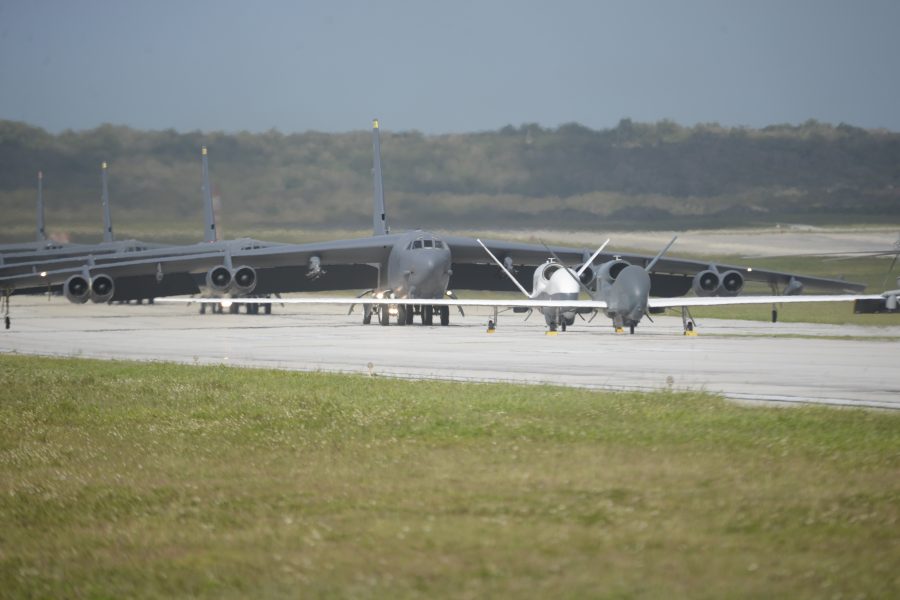The impact of the new coronavirus outbreak has been mixed for USAF flying units, with many close to the fight maintaining a high operations tempo, while training at home takes a major hit that could have lasting impacts to readiness. However, the service has faced similar cutbacks before and will be prepared to bounce back, Chief of Staff Gen. David Goldfein told Air Force Magazine in an April 15 interview.
The spread of COVID-19 forced a reset across the Air Force, beginning with a report from all major commands to service leadership on what tasks are mission essential and others that can be curtailed.
“The first thing we did was we identified the key missions that we know we will get no relief on, nor should we expect relief when it comes to defending the homeland and doing those other critical missions,” Goldfein said.
Those critical missions include:
- Nuclear deterrence and related support
- Ongoing combat operations, including sustained intelligence, surveillance, and reconnaissance
- Continued cyber operations
- Standing up the Space Force
“So we identified the missions that we know we have to continue and then the ask was: OK, how do you build the breadth and depth to be able to sustain operations even if there’s an outbreak?” he said. “We’ve adjusted operations in the nuclear missile fields, we’ve adjusted operations in our command and control headquarters, we’ve made adjustments in how we maintain space operations. … We’re operating in what we call the new abnormal, operating with the virus.”
For nuclear operations, missileers have dramatically changed their alert procedures. Typically, a nuclear crew would go on about eight alerts per month for about two to three days each time. But that timeline has been increased so missileers are now in the field for 14 days or more.
“We’re continuing to adjust our operations, so that we’re adhering to [Centers for Disease Control and Prevention] protocols at the same time,” he said. “And operations continue unabated.”
Air mobility is another mission that must continue, with an operations pace that has increased amid the coronavirus outbreak. Crews flying these missions essentially remain in a “bubble,” flying a mission in a clean cockpit, moving to their rooms with no contact with others, and then returning to the plane.
“So global mobility continues unabated,” he said. “And I expect, actually, the demand signal for global mobility to go up in the weeks ahead. It will not go down.”
The pace of flights is high at forward locations, such as Bagram Airfield, where Airmen continue to support the combat mission there in Afghanistan, or at Kunsan Air Base, South Korea, where “fight tonight” forces cannot have degradation. However, other bases and commands that don’t have as much of an urgent operational need, like Air Education and Training Command, have seen their flying hours cut back by approximately half.
The service also is closely watching the impact of the outbreak on its depots.
“Our civilian workforce in the depots are just magicians,” Goldfein said. “They keep 58-year-old airplanes flying. I mean, it’s just magic what they do, but they also tend to be an older population, so therefore at greater risk.”
Air Force Materiel Command is adjusting depot operations to limit the potential future impact on aircraft availability and the status of aircraft modification, which in turn has future impacts on the flying hour program, Goldfein said.
On a smaller scale, the service has seen similar issues before. For example, maintenance-related stand downs with the B-1B fleet in recent years impacted the service’s ability to keep pilots current and maintain overall readiness.
“Though we’ve not been through a global pandemic before, we have been through times where we’ve had to ground fleets for some period of time because of a maintenance action, and then have to reconstitute that fleet,” he said. “And so, we actually have some good templates and we know how to do this.”
The service also saw major impacts to its flying operations when sequestration was implemented in 2013. Those broad, across-the-board cuts are still having impacts on USAF readiness today, Goldfein said. However, the recovery has produced some lessons learned “in terms of how we eventually got back up on the step,” he added.
“But I would say that there are more current examples … of maintenance groundings and what have you that we’ve been through, where we’ve had to reconstitute and rebuild readiness, and so that muscle memory is not too far back,” Goldfein said.
The Air Force on April 13 made a major public show of its readiness in the Pacific. Four B-52s, along with KC-135s, an RQ-4 Global Hawk, and U.S. Navy aircraft conducted an “elephant walk” at Andersen Air Force Base, Guam, to show USAF can launch the heavy bombers and support aircraft on short notice. Steps like this are important for Americans, and the world, “to know that its Air Force is up and operating, and this would be a dangerous time to even consider taking us on,” Goldfein said. “We can generate airplanes. We can generate air power. We can generate space power.”

The exercise gave Airmen a chance to work in a high-pressure situation amid the pandemic. Despite social distancing rules and CDC guidelines, air traffic controllers, pilots, maintainers, weapons loaders, etc., had to get those airplanes ready.
“There’s 1,000 fingerprints on an aircraft that gets airborne, and so every one of those operations has got to be modified and adjusted,” Goldfein said. “And so, we learn, and we do an elephant walk. How do you do air traffic control in a COVID environment? How do you build weapons in a COVID environment? How do you refuel aircraft, and operate a fuel truck? These are all things that we’re modifying real time, and so it’s a great exercise to ensure that we can continue to produce airpower despite the COVID challenges.”
